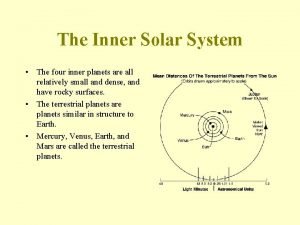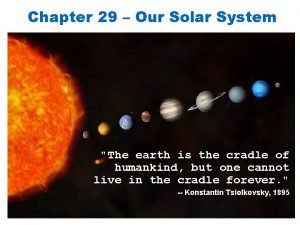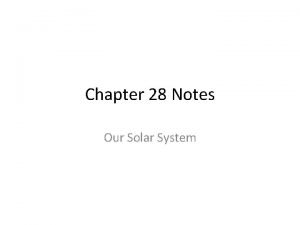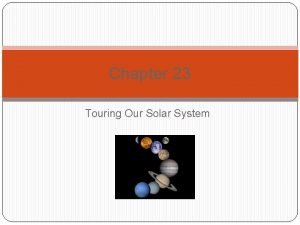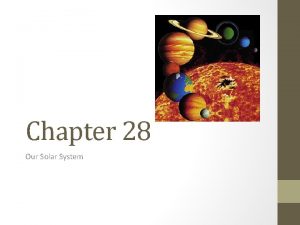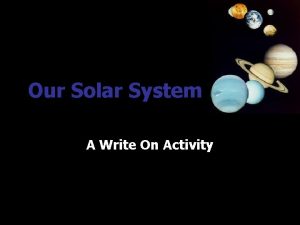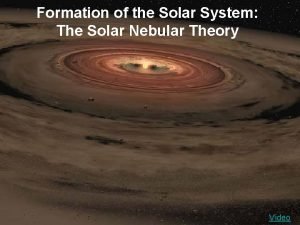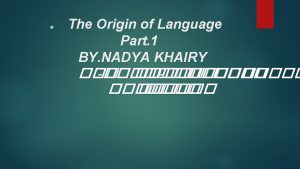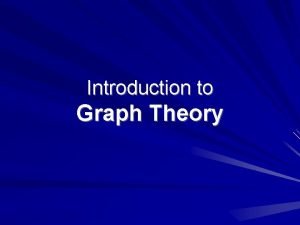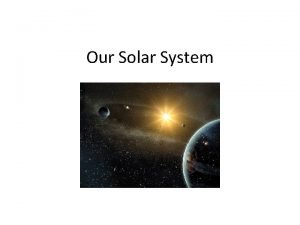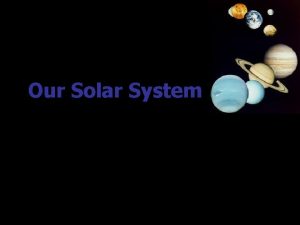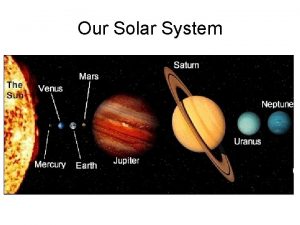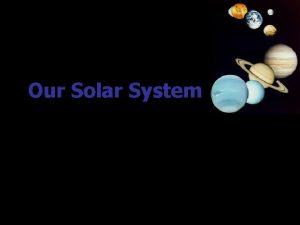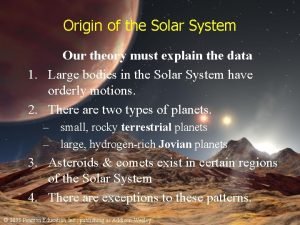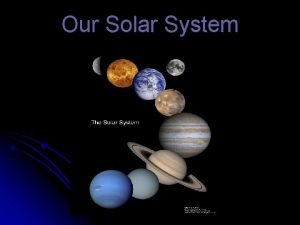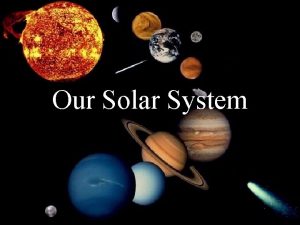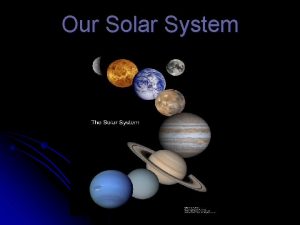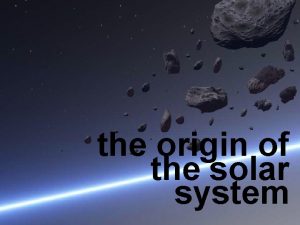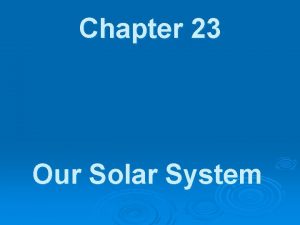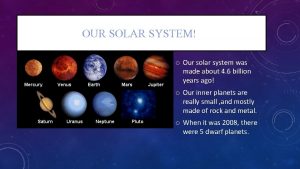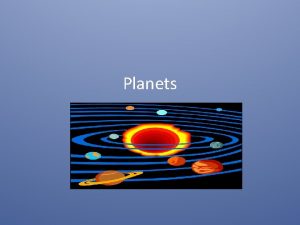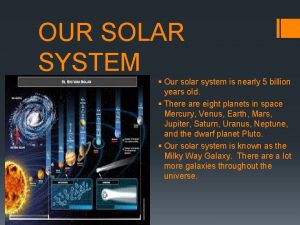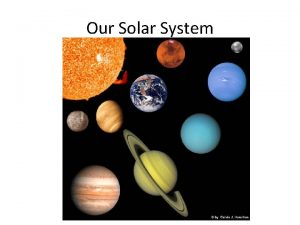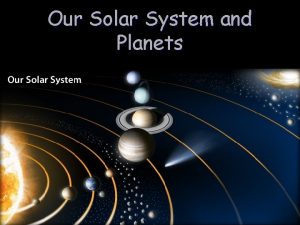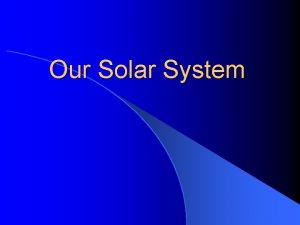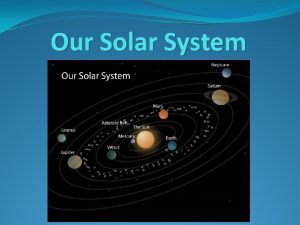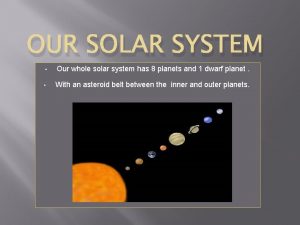Origin of the Solar System Our theory must





























- Slides: 29

Origin of the Solar System Our theory must explain the data 1. Large bodies in the Solar System have orderly motions. 2. There are two types of planets. – small, rocky terrestrial planets – large, hydrogen-rich Jovian planets 3. Asteroids & comets exist in certain regions of the Solar System 4. There are exceptions to these patterns. © 2005 Pearson Education Inc. , publishing as Addison-Wesley

The Solar Nebula • The nebular theory holds that our Solar System formed out of a nebula which collapsed under its own gravity. • observational evidence – We observe stars in the process of forming today. – The are always found within interstellar clouds of gas. solar nebula – name given to – This image shows the Orion Nebula. . newborn solar systems the cloud of gas from which our own Solar System formed within! © 2005 Pearson Education Inc. , publishing as Addison-Wesley

Gravitational Collapse • The solar nebular was initially somewhat spherical and a few light years in diameter. – very cold – rotating slightly • It was given a “push” by some event. – perhaps the shock wave from a nearby supernova • As the nebula shrank, gravity increased, causing collapse. • As the nebula “falls” inward, gravitational potential energy is converted to heat. – Conservation of Energy • As the nebula’s radius decreases, it rotates faster – Conservation of Angular Momentum © 2005 Pearson Education Inc. , publishing as Addison-Wesley

Flattening of the Solar Nebula • As the nebula collapses, clumps of gas collide & merge. • Their random velocities average out into the nebula’s direction of rotation. • The spinning nebula assumes the shape of a disk. © 2005 Pearson Education Inc. , publishing as Addison-Wesley

Why does the cloud spin? • Its part of a spinning galaxy—lots of angular momentum avaialble • Particles closer to the center of galaxy move more rapily than particles farther away. . speed decreases with radial distance. • As a shock wave and then gravity compress the cloud, angular momentum must be conserved, so toques transfer some angular momentum from the galactic disk to the interstellar cloud. • This is similar to the formation of cyclones and hurricanes in our atmosphere. © 2005 Pearson Education Inc. , publishing as Addison-Wesley

The Coriolis effect • Air moves fastest at the equator due to the Earths Spin • As temp differences causes air currents to move North south, the result is a whilpool of air © 2005 Pearson Education Inc. , publishing as Addison-Wesley

Rotating disk with collapsing cloud Imagine disk of Galaxy seen from above Note: Speed decreases With radial distance Stars in Galaxy orbit about center of galaxy © 2005 Pearson Education Inc. , publishing as Addison-Wesley

Rotating disk with collapsing cloud Centripital force (gravity) makes particles orbit center of cloud, while cloud orbits center of galaxy. Particles on outside rotate more slowly about galactic center Stars on inside rotate more rapidly Collisions occur Faster particles will win! Disk begins to swirl! © 2005 Pearson Education Inc. , publishing as Addison-Wesley

Collapse of the Solar Nebula © 2005 Pearson Education Inc. , publishing as Addison-Wesley

Orderly Motions in the Solar System • The Sun formed in the very center of the nebula. – temperature & density were high enough for nuclear fusion reactions to begin • The planets formed in the rest of the disk. • This would explain the following: – – – all planets lie along one plane (in the disk) all planets orbit in one direction (the spin direction of the disk) the Sun rotates in the same direction the planets would tend to rotate in this same direction most moons orbit in this direction most planetary orbits are near circular (collisions in the disk) © 2005 Pearson Education Inc. , publishing as Addison-Wesley

More Support for the Nebular Theory • We have observed disks around other stars. • These could be new planetary systems in formation. Pictoris AB Aurigae © 2005 Pearson Education Inc. , publishing as Addison-Wesley Proto-Solar systems in the Orion Nebula!

Building the Planets Condensation – elements & compounds began to condense (i. e. solidify) out of the nebula…. depending on temperature! Imagine atoms and molecules coming together atom by atom—electric force and ionization is main mechanism © 2005 Pearson Education Inc. , publishing as Addison-Wesley

Building the Planets …and temperature in the Solar nebula depended on distance from the Sun! © 2005 Pearson Education Inc. , publishing as Addison-Wesley

The Young Sun emitted pulses of UV and X-rays • These photons ionized some atoms in the solar nebula and deposited charge on others • These made the atoms and molecules “sticky” • Try to slide down a plastic slide on a dry, sunny day. Your hair will stand up! © 2005 Pearson Education Inc. , publishing as Addison-Wesley

Building the Planets So only rocks & metals condensed within 3. 5 AU of the Sun… the so-called frost line. Hydrogen compounds (ices) condensed beyond the frost line. © 2005 Pearson Education Inc. , publishing as Addison-Wesley

Building the Planets accretion -- small grains stick to one another via electromagnetic force until they are massive enough to attract via gravity to form. . . acretion is mostly a gravitational effect. . macroscopic objects attracting one another © 2005 Pearson Education Inc. , publishing as Addison-Wesley

Acretion continues today! © 2005 Pearson Education Inc. , publishing as Addison-Wesley

Building the Planets …After condensation produces macrosopic objects will: • These combine near the Sun to form rocky planets • combine beyond the frostline to form icy planetesimals which… • capture H/He far from Sun to form gas planets © 2005 Pearson Education Inc. , publishing as Addison-Wesley

Building the Planets • Each gas (Jovian) planet formed its own “miniature” solar nebula. • Moons formed out of the disk. © 2005 Pearson Education Inc. , publishing as Addison-Wesley

Building the Planets solar wind --- charged particles streaming out from the Sun cleared away the leftover gas—this might be a relatively rare event! Other solar systems show evidence that their nebulae weren’t cleared out! © 2005 Pearson Education Inc. , publishing as Addison-Wesley

Origin of the Asteroids • The Solar wind cleared the leftover gas, but not the leftover planetesimals. • Those leftover rocky planetesimals which did not accrete onto a planet are the present-day asteroids. • Most inhabit the asteroid belt between Mars & Jupiter. – Jupiter’s gravity prevented a planet from forming there. © 2005 Pearson Education Inc. , publishing as Addison-Wesley

Origin of the Comets • The leftover icy planetesimals are the present-day comets. • Those which were located between the Jovian planets, if not captured, were gravitationally flung in all directions into the Oort cloud. • Those beyond Neptune’s orbit remained in the ecliptic The nebular theory predicted the existence plane in what we call of the Kuiper belt 40 years before it was the Kuiper belt. discovered! © 2005 Pearson Education Inc. , publishing as Addison-Wesley

Exceptions to the Rules So how does the nebular theory deal with exceptions, i. e. data which do not fit the model’s predictions? • There were many more leftover planetesimals than we see today. • Most of them collided with the newly-formed planets & moons during the first few 108 years of the Solar System. • We call this the heavy bombardment period. © 2005 Pearson Education Inc. , publishing as Addison-Wesley

Exceptions to the Rules Close encounters with and impacts by planetesimals could e • Why some moons orbit opposite their planet’s rotation – captured moons (e. g. Triton) • Why rotation axes of some planets are tilted – impacts “knock them over” (extreme example: Uranus) • Why some planets rotate more quickly than others – impacts “spin them up” • Why Earth is the only terrestrial planet with a large Moon – giant impact © 2005 Pearson Education Inc. , publishing as Addison-Wesley

Formation of the Moon (Giant Impact Theory) • The Earth was struck by a Mars-sized planetesimal • A part of Earth’s mantle was ejected • This coalesced in the Moon. – it orbits in same direction as Earth rotates – lower density than Earth – Earth was “spun up” © 2005 Pearson Education Inc. , publishing as Addison-Wesley

Formation of Moon See: move at: http: //yso. mtk. nao. ac. jp/~kokubo/ moon/kit/movie. html (illustration from Joe Tucciarone http: //www. monkeytime. com/sciencemaster/ galleries/jt_space/gallery. php) © 2005 Pearson Education Inc. , publishing as Addison-Wesley

9. 5 How Old is the Solar System? • How do we measure the age of a rock? • How old is the Solar System and how do we know? © 2005 Pearson Education Inc. , publishing as Addison-Wesley

Radiometric Dating • Isotopes which are unstable are said to be radioactive. • They spontaneously change in to another isotope in a process called radioactive decay. – protons convert to neutrons – neutrons convert to protons • The time it takes half the amount of a radioactive isotope to decay is called its half life. • By knowing rock chemistry, we chose a stable isotope which does not form with the rock…its presence is due solely to decay. • Measuring the relative amounts of the two isotopes and knowing the half life of the radioactive isotope tells us the age of the rock. © 2005 Pearson Education Inc. , publishing as Addison-Wesley

The Age of our Solar System • Radiometric dating can only measure the age of a rock since it solidified. • Geologic processes on Earth cause rock to melt and resolidify. Þ Earth rocks can’t be used to measure the Solar System’s age. • We must find rocks which have not melted or vaporized since the condensed from the Solar nebula. – meteorites imply an age of 4. 6 billion years for Solar System – This value is consistent with the age of the oldest moon rocks (4. 4 billion years) • Radioactive isotopes are formed in stars & supernovae – suggests that Solar System formation was triggered by supernova – short half. Inc. , lives suggest the supernova was nearby © 2005 Pearson Education publishing as Addison-Wesley
 The four inner planets of our solar system are
The four inner planets of our solar system are Chapter 29 our solar system
Chapter 29 our solar system Chapter 28 our solar system
Chapter 28 our solar system Chapter 23 touring our solar system
Chapter 23 touring our solar system Chapter 28 our solar system
Chapter 28 our solar system What are the inner and outer planets
What are the inner and outer planets Biggest planet in our solar system
Biggest planet in our solar system Our solar system
Our solar system Sunpower panels wholesale
Sunpower panels wholesale Inexhaustible source of energy
Inexhaustible source of energy He must become greater; i must become less
He must become greater; i must become less Thinking language and intelligence
Thinking language and intelligence Our census our future
Our census our future Christ be our light
Christ be our light Our life is what our thoughts make it
Our life is what our thoughts make it We bow our hearts
We bow our hearts Our census our future
Our census our future Our life is what our thoughts make it
Our life is what our thoughts make it Kitna
Kitna Awareness of ourselves and our environment is
Awareness of ourselves and our environment is Awareness of ourselves and our environment is
Awareness of ourselves and our environment is God our father christ our brother
God our father christ our brother Our future is in our hands quotes
Our future is in our hands quotes Our awareness of ourselves and our environment.
Our awareness of ourselves and our environment. Awareness of ourselves and our environment is:
Awareness of ourselves and our environment is: Nebular hypothesis diagram
Nebular hypothesis diagram What are the sources of language
What are the sources of language Graph theory history
Graph theory history Origin of graph theory
Origin of graph theory Origin of graph theory
Origin of graph theory
